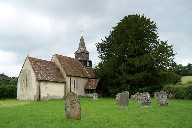| |
 
CHURCHYARD
YEWS
.jpg) |
|
Many village
churchyards boast a large yew tree, and
often more than one, but no two people
agree as to just why it’s there.
Some of our churches are a thousand years
old, but in places the trees are even
older - no-one knows quite how old as
yews are notoriously difficult to date.
It has even been said that they are
relics of pagan worship.
So let’s have a look at the story of
the churchyard yew, and in particular at
some fine specimens close at hand. Yew
trees certainly featured in Celtic
religion, symbolizing the mystical
continuity of life, and in the same way
may have become a meeting place for early
Christian missionaries, to whom their
significance was a reminder of eternity
and constancy of faith. |
These missionaries built
their own churches in the same spot, first of
wood and then of stone, many of which remain
scattered in lonely places among the Downs of
Sussex and Hampshire.
In 1307, Edward I
ordered that yew trees be planted in
churchyards to protect the buildings from
high winds and storms, and at the same
time to keep animals out of the
churchyard, as they are poisonous to
livestock.
Yews will grow in any soil, but thrive
where it is alkaline. Consequently they
are scarce in East Anglia, but are found
from the west of Wales to the north of
Scotland. In the south of England they
are particularly common, and the most
famous yew wood in Europe is at Kingley
Vale, just north of Chichester, whose
mysteries I have described before in
these columns.
|
|
.jpg) |
The finest churchyard yew I
know is at Much Marcle, in Herefordshire. Its
branches spread seventy feet and are supported by
a huge iron frame, whilst its trunk, which is
quite hollow, is thirty feet in girth. From time
immemorial it has been a meeting place, and six
people can sit comfortably on the seats inside
the hollow trunk.
.jpg) |
|
The most famous
tree in Hampshire used to be at Selborne.
Gilbert White measured its girth as 23 ft
9 in in 1789, and it subsequently became
one of the best known trees in the
kingdom. It was blown down in the storm
of January 1990, but was re-erected and
seemed to be surviving, although it
eventually died and the stump has been
left to decay. An altar made from parts
of the wood has been erected inside the
church. The
stump of another famous yew remains at
Privett, now covered with brambles. The
new church was built too close and the
tree was heavily pollarded, causing it to
die. It was perhaps one of the hundred
oldest in the country.
|
Three other fine, healthy
yews nearby are all found beside churches which
can claim Saxon origin, so it could well be they
were there before the present buildings.
Corhampton church retains many of its original
features, and its yew is 24 ft in girth, with a
fine, clean trunk and branches which have been
allowed to reach the ground and become embedded
in the earth.
At Priors Dean the
tree is even bigger, measuring 26 ft just
above the ground. It was first mentioned
as long ago as 1848 in A Topographical
Dictionary of England. At Newton Valance,
close by, the trunk is smaller, a mere 18
ft. in girth, but the tree appears
larger, as the branches trail across the
path and among the gravestones. The
hollow parts are filled with concrete.
There are other fine yews at Bramshott,
Greatham Old Church, Hawkley and Steep,
all growing and changing imperceptibly as
the years and the centuries pass, and
witness to more than a thousand years of
village life.
|
|
 |
Tom Muckley, November 2007
This article was originally
published by the
Petersfield Post
tommuckley.co.uk
|
|


.jpg)
.jpg)
.jpg)
